Despite its meteoric popularity among gardeners, the African violet is still intimidating to some. Most of that intimidation comes from its care quirks, namely choosing the right potting mix for African violets.
Fear not, houseplant lovers, I’m here to help you master your new plant! With some straightforward tips, you’ll be more motivated than ever to go out and get your every own African violet!
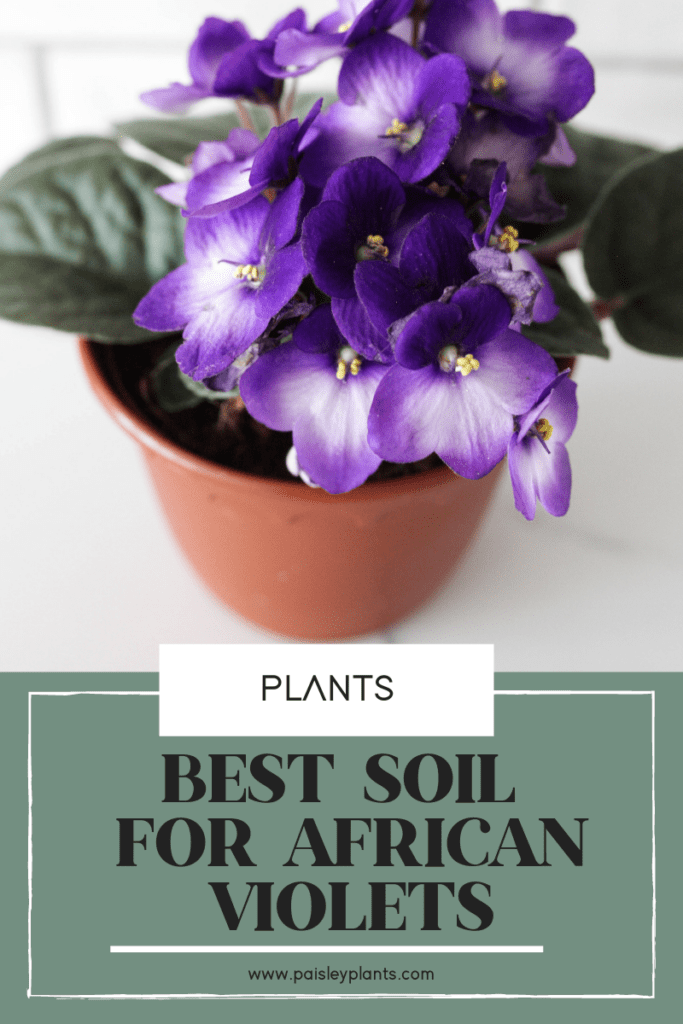
Table of Contents
Background
As you have already guessed, the African violets are native to the regions of eastern Africa, namely the tropical rainforests of Tanzania and Kenya. In the late 18th century, a German colonialist by the name of Walter von Saint Paul-Illaire took notice of these plants and sent the seeds back to Germany.
Ever since, the African violet has transcended the homes of gardeners worldwide and has become one of the most popular houseplants.
African violets are small plants (even their largest varieties do not exceed 16 inches), which makes them great houseplants for gardeners living in small spaces. Not only that, but they are non-toxic to pets, including cats and dogs- another one of many reasons to invest in African violets.
Despite what their name suggests, the African violets are not actually violets at all- though their flowers do produce the most vibrant shade of purple! African violets were once a member of a genus called Saintpaulia, though in recent years, their genus name has changed to Streptocarpus.
What Soil Do You Need for African Violets?
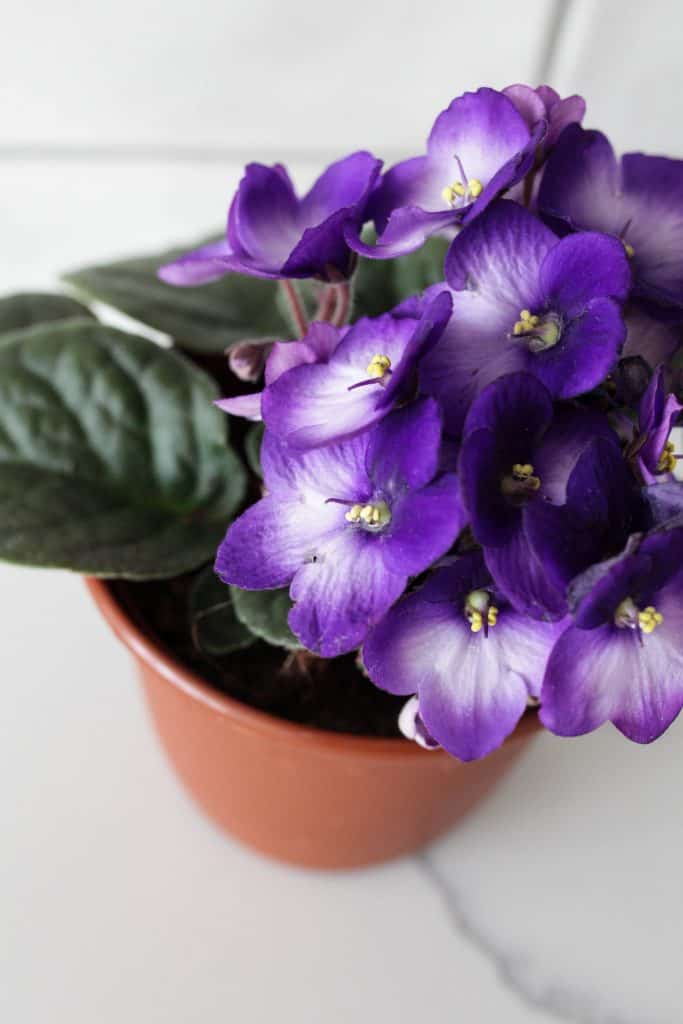
African violets naturally have a very fine, delicate root system. As a result, you can’t give them a regular potting mix, they require a bit of a special soil, one that’s slightly acidic, well-draining potting mix. Let’s break down the main components of what makes the perfect African violet soil mixture.
Drainage
In the African violet’s natural habitat, they are often found growing from the crevices of mossy rocks. In this location, they receive ample airflow while also allowing the proper amount of water retention.
You can try to replicate this environment by choosing a potting mix that is well draining and allows excess water to pass through while also retaining enough moisture to keep the plant healthy.
Ingredients
The ideal potting mix for African violets does not contain standard soil, but rather an aerated mixture of both draining and moisture-retentive ingredients.
Examples of materials you may find in a commercial pre-mixed bag of African violet soil includes sphagnum peat moss, coarse sand, perlite, vermiculite, pumice.
Fertilizer
Fertilizer is beneficial to your African violets as they promote healthy and fortified growth.
You can help fertilize an African violet potting mix by including either organic compost, composted bark, or even earthworm castings. All of these will provide strong health benefits to your African violets.
How to DIY Soil for African Violets
While a potting mix for African violets might seem complicated, it can really be composed only of a couple ingredients. Let’s take a look at how to DIY your own mix at home, and the best part is how easy it is!
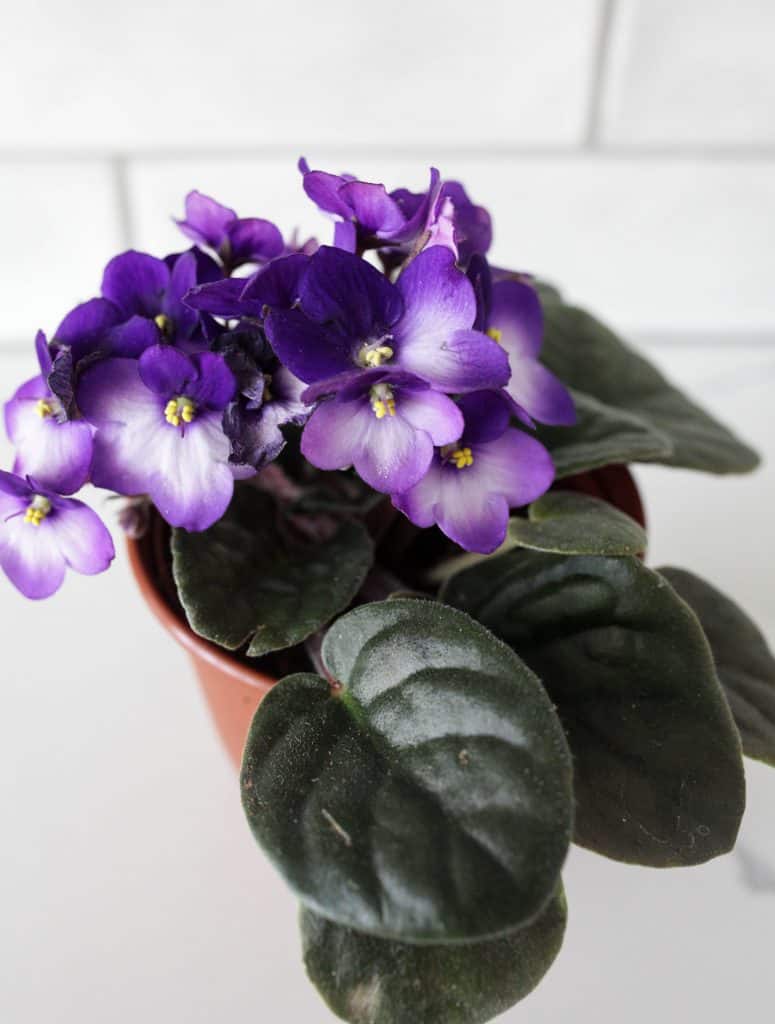
The most basic African violet mixture can be made up 50% sphagnum peat moss and 50% perlite or vermiculite. The sphagnum peat moss acts as a water retainer, making sure your plants are hydrated. The perlite/vermiculite creates air pockets in the soil, which aids in airflow and encourages fortified root growth in your plants.
You can make a 50:50 mix of peat moss to perlite, or even a 50:25:25 ratio of peat moss to perlite to vermiculite. As long as you retain that 50% peat moss, you have a basic bare-bones DIY African violet soil.
For added nutritional benefit to your soil, try working in some organic matter or earthworm castings. Traditional fertilizer may be used as well, but please be sure to use a heavily diluted mixture.
Before you make your own fresh soil, you’ll need to treat it first! You’ll want to eliminate any bacteria, diseases, insects, or anything else you wouldn’t necessarily want in your potting soil.
Best part is, this isn’t hard! All you’ll need to do is spread out your potting mixture onto a large pan. Set your oven temperature to 180 degrees Fahrenheit.
Cover your pan with aluminum foil and put it in your preheated oven. Cook for an hour, using a meat thermometer to ensure the temperature stays at 180 degrees.
It’s best to let is sit for four days before you go to pot your new plant. Give it a good stir a few times a day to aerate it. That’s it!
Best Soil Mixes for African Violets
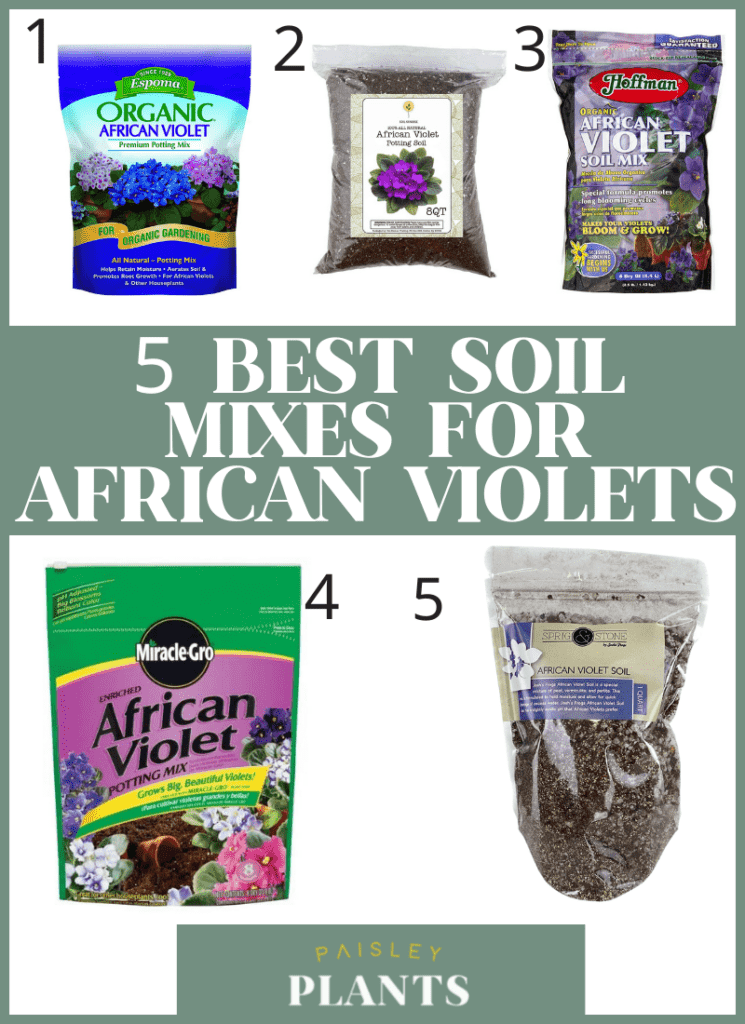
This post includes affiliate links.
1. Best Overall Mixture: Espoma Organic African Violet Potting Mix
If you’re looking for an overall great potting mix, then look no further. This potting mix from Espoma is not only organic, but it contains excellent essential ingredients.
With this potting mix, you do not have to worry about synthetic chemicals in your soil mixture. This mix comes in a 4 quart bag, so even if you live in a small space, you can still store it without worry about it being too bulky.
2. All Natural, Hand Mixed Soil: Soil Sunrise African Violet Potting Soil
This soil mixture from Soil Sunrise brags that is 100% all-natural hand mixed soil, catered perfectly to your African violets. This potting mix not only contains ingredients tailored to give your African violets a well-draining, aerated environment, but they’ve also included worm castings as plant food.
This potting mix comes in 4 and 8 quart bags and contains natural ingredients including perlite, peat, worm castings, and lime.
3. Synthetic-free potting mix: Hoffman Organic African Violet Soil Mix
Another excellent choice for gardeners who want a soil mix that is guaranteed organic, this Hoffman African violet soil is the right choice for you. This 4 quart soil mix boasts that they are an organic, well-draining, aerated potting mix.
4. Pre-Fertilized Mixture: Miracle-Gro African Violet Potting Mix
The household brand name Miracle-Gro has done it again with this potting mix specifically designed for African violets. This 8 quart bag of potting mix contains plant food that will help feed your African violets for up to 3 months.
5. Best for small spaces: Sprig & Stone African Violet Soil
If you’re a small-space gardener living in a place with little storage, this potting mix from Sprig & Stone is right up your alley. Containing 1 quart of soil, this is the perfect amount to fill up one African violet pot.
This soil provides good drainage and composed of peat moss, perlite, and vermiculite, which allows for airflow for your violets’ root system.
African Violet Care
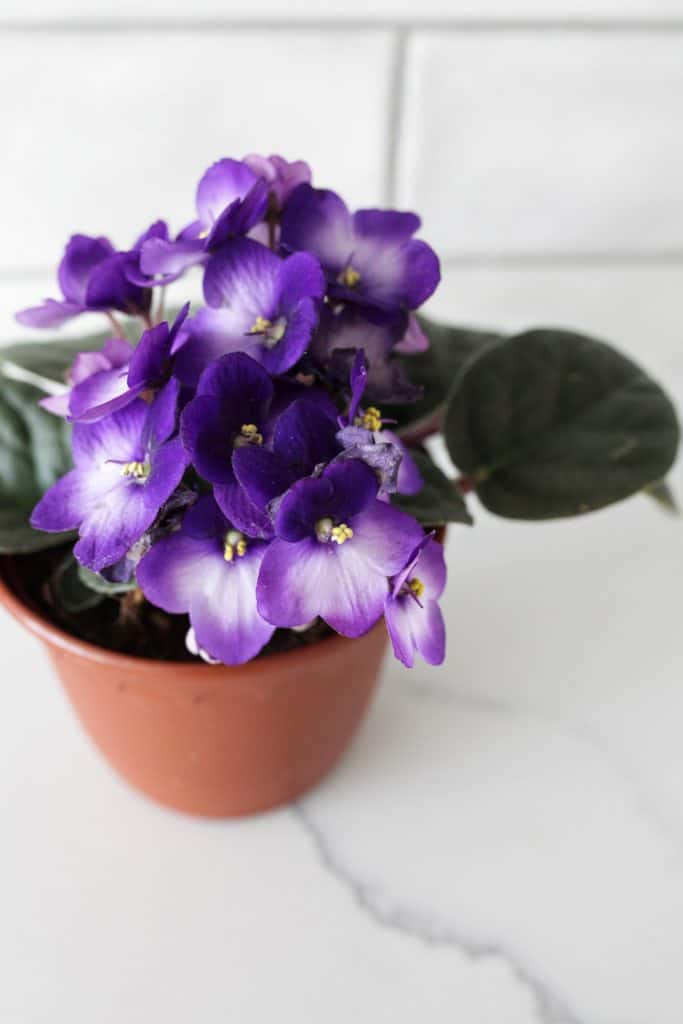
How much light do African Violets need?
African Violets do best with indirect bright light. If you have them near a south facing windows or a west window, be sure to have to have them pulled back a bit so they don’t get direct sunlight.
Do You Water African Violets from the Bottom?
Watering African violets can be quite tricky compared to other houseplants. First and foremost, for best results you should never allow your African violets’ foliage to get wet; try to water as close to the base as possible to avoid this.
Many owners of African violets also opt to water their plants from the bottom. There are two methods of bottom watering: setting the pot in water and wicking. Let’s go over the two methods.
Setting in Water
- Fill a bowl of water 1 inch deep; this water should be room temperature.
- Place the pot into the water bowl.
- Monitor the top of the soil; when it begins to feel moist to the touch, remove the pot from the water and wait until the excess drains out from the bottom of the pot.
Wicking
- A wick is a string of absorbent material (often nylon or polyester) that is used to draw water from a water reservoir into the soil, which gives the soil a steady stream of moisture.
- Thread a wick through one of the drainage holes in your plant pot; allow a few inches to hang out from the bottom of the pot.
- Transfer your African violets into the pot with the wick still intact.
- Pour another bowl of water and set the violets’ pot on top of the reservoir. Make sure the wick at the bottom is totally submerged in water. The wick should absorb the liquid and moisten your soil.
Alternatively, you can opt to buy a self-watering planter at any garden retailer, which waters your plant via a wicking system. This will help prevent your African Violet from getting too much water!
I have a full post on the best pots to water your African Violet plants (everything from clay pots to plastic pots).
Frequently Asked Questions
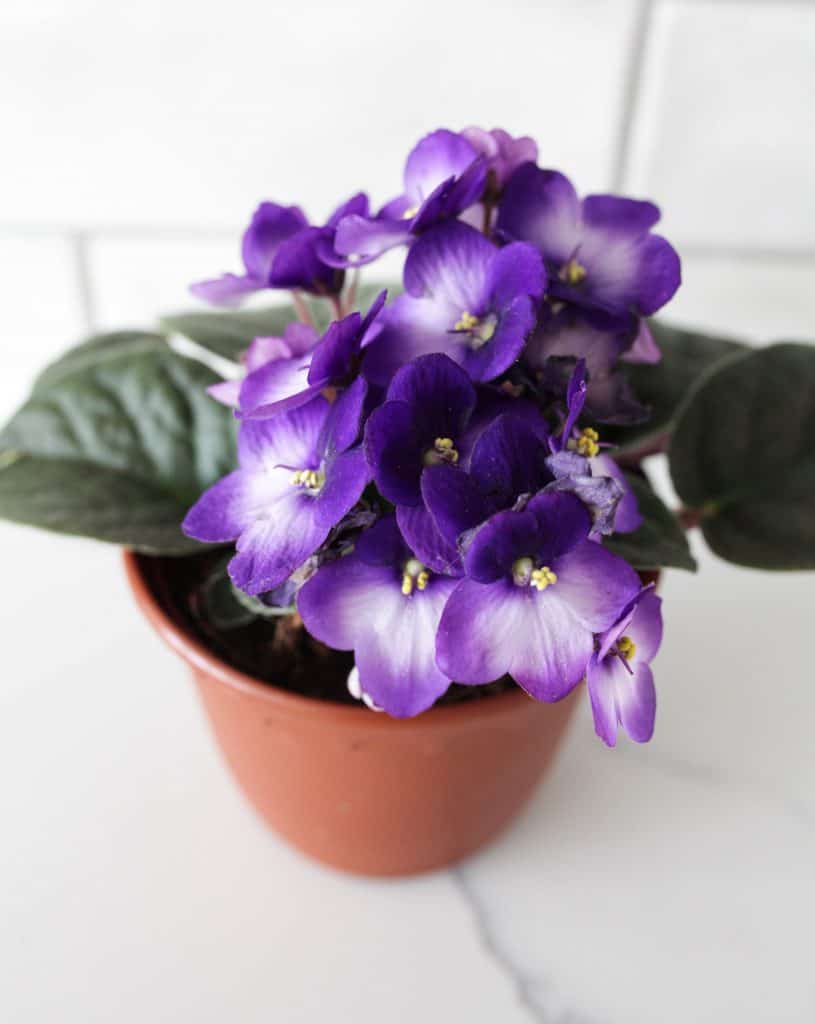
Yes they do need a special type of soil. African violets need a potting soil that is specially curated to fit their needs and replicate their growing conditions in their native habitat. In the tropics of eastern Africa, African violets grow from the crevices of mossy rocks, not from regular potting soil.
Planting your African violets in regular soil with no amendments is simply dangerous for your plant. Regular household soil is too heavy and dense; it restricts airflow between the thin roots of the African violet.
Instead, African violets should be planted in an aerated mixture of non-soil materials such as perlite, sand, and peats moss, to name a few.
For the convenience of gardeners everywhere, many retailers sell pre-mixed packs of African violet soil that will keep your plants healthy and happy.
While succulents do check off some of the boxes for African violets, these two potting mixes are by no means interchangeable. The primary reason being: moisture retention.
While we have been adamant about how the African violets thrive in a soilless potting mix that contains many of the well-draining ingredients you’ll find in most succulent soil, soil for succulents lacks the moisture retaining qualities African violets need to survive.
One of the most important ingredients in African violet potting mix is peat moss, an ingredient used to retain moisture and keep the root system hydrated. Peat moss composes 50% of African violet potting mix, which is a significant quantity.
While you can amend a succulent soil with peat moss to match that of African violet soil, I highly discourage the use of succulent soil straight from the bag.
In terms of repotting to a different sized larger pot, African violets do best when they’re under-potted (the opposite of root-bound). Repotting to a larger planter should only be done when necessary.
Repot your African violets to the next size up when the time comes. African violets that are root bound will show you symptoms including falling leaves and roots growing out of the soil. Monitor your plants for these signs and repot when you see fit.
While you shouldn’t change your African violet’s pot size until absolutely necessary, you should switch out the soil about once a year. Replenishing the soil in your plant’s pot is beneficial in reviving the essential nutrients that are been lost over time.
Closing
While the African violet might be an immensely popular houseplant, many new gardeners tend to shy away from this beauty because they fear that they’ll be too difficult to care for.
I say, don’t shy away from the African violet! Just because they use a different soil doesn’t mean that they’re a difficult plant. Once you’ve settled on the perfect soil mixture, then the rest is a breeze.
Want more? Head here for the best pots to water your African Violet!
African Violet plants are non-toxic and safe for cats and pets. Find more pet friendly plants here and other low-light pet safe plants on this post!

